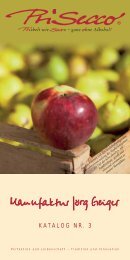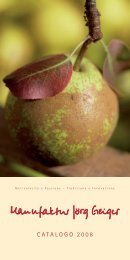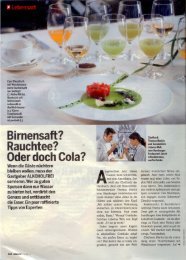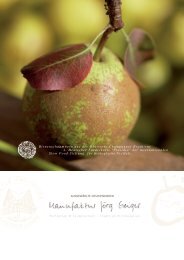CATALOGUE 2009 - Manufaktur Jörg Geiger, Apfelweincocktails ...
CATALOGUE 2009 - Manufaktur Jörg Geiger, Apfelweincocktails ...
CATALOGUE 2009 - Manufaktur Jörg Geiger, Apfelweincocktails ...
You also want an ePaper? Increase the reach of your titles
YUMPU automatically turns print PDFs into web optimized ePapers that Google loves.
The Champagne baking pear may<br />
well be an old Württemberger<br />
variety. It originated from an accidental<br />
seedling, as do almost all old<br />
fruit species. In Duke Carl Eugen’s<br />
tree nursery, the Champagne baking<br />
pear was propagated in large numbers<br />
due to its high local importance<br />
so that it could be distributed by the<br />
agricultural patron throughout the<br />
whole of the state of Württemberg.<br />
According to Lucas, around 1850 it<br />
was commonly found on the Filder<br />
elevated plain near Stuttgart, in<br />
the Neckar and Rems valleys and<br />
in many regions of the state. The<br />
tree established itself at medium<br />
altitudes from 300 to 450 m above<br />
sea level, especially in conditions<br />
favourable to creating microclimates<br />
on warmer soils. Today we<br />
find the trees in particular in certain<br />
regions along the Albtrauf, the<br />
northwestern border of the Swabian<br />
Alb mountain range.<br />
Schlat, with its favourable position<br />
for fruit cultivation, has preserved a<br />
vital crop thanks to the attachment of<br />
the local people to their Champagne<br />
baking-pear trees and to the knowledge<br />
of its fruit growers.<br />
The main crop in Schlat is now<br />
between 90 and 120 years old, with<br />
a small part in the middle age range<br />
at 30 years old and newly planted<br />
trees from the last five years that<br />
still have some growing ahead of<br />
them before they begin to deliver<br />
any significant yield after 20 years of<br />
cultivation. A high-standing tree first<br />
completes its natural growth spurt<br />
and only then starts to bear fruit.<br />
This is an example of a tree really<br />
being planted and cultivated for the<br />
next generation, where long-term<br />
management is required.<br />
Our traditional orchards in the<br />
area around the Albvorland, located<br />
below the Albtrauf, are the largest<br />
area of biodiversity north of the<br />
Alps. The outstanding range of<br />
species there is important for all the<br />
ecosystems in central Europe. With<br />
more than 5000 animal and plant<br />
2<br />
species, not counting fungi, lichens<br />
and mosses, this is unique in the<br />
area north of the Alps. The dominant<br />
species of birds found in the traditional<br />
orchard include the little owl,<br />
wryneck, woodchat shrike, green<br />
woodpecker and collared flycatcher.<br />
The traditional orchard is therefore<br />
of the highest importance for the<br />
biodiversity of central Europe,<br />
comparable with the standard olive,<br />
cork and Holm oak tree forests of<br />
southern Europe.<br />
In 2007 the traditional orchards of<br />
the Albtrauf were declared an EU<br />
bird sanctuary.<br />
At the Albtrauf, there is a unique<br />
natural harvest on well-tended<br />
traditional orchards of old fruit<br />
varieties growing on high-standing<br />
trees that produce fruits of<br />
particular taste and quality.<br />
In our fruit workshop, we collect and<br />
cultivate these rare varieties individually<br />
and get the best out of them,<br />
always respecting the traditional<br />
usage, with the best knowledge of<br />
winegrowing and always driven by<br />
those so very “Swabian” virtues of<br />
passion and perfection.<br />
Let yourself be seduced by stimulating<br />
and simple companions and the<br />
aromas of our natural surroundings<br />
in hand-crafted perfection!











